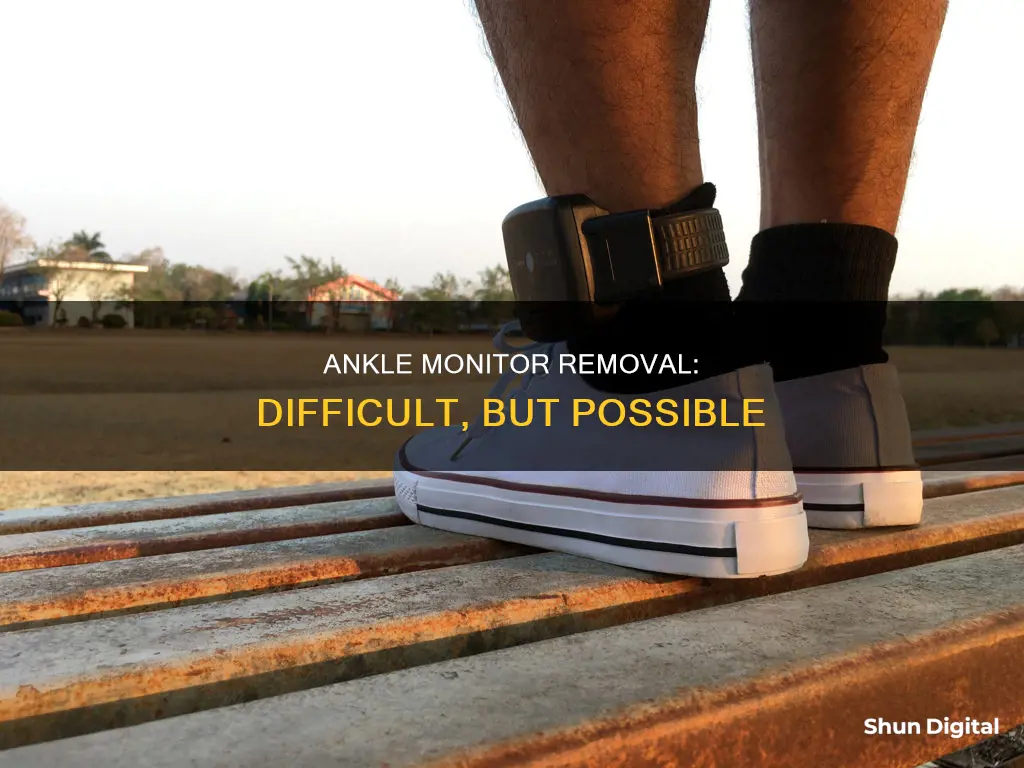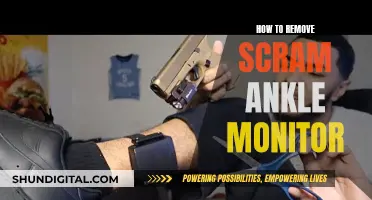
Removing an ankle monitor can be challenging, but it is possible to do so legally. The proper way to request the court to remove your ankle monitor is by submitting a motion. This can be done by anyone, but it is recommended that you consult a lawyer to increase your chances of success. The process of creating and submitting a motion can be tricky, as there are rules and protocols to follow, and certain wordings and sentence constructions are considered proper. It is also important to have a legitimate reason for wanting to remove the ankle monitor, as this will need to be explained to the judge.
| Characteristics | Values |
|---|---|
| Legality | Removing an ankle monitor without permission is illegal |
| Legal removal | Submit an official request to the court |
| Request requirements | A legitimate reason for removal |
| Request requirements | A supervision officer's support |
| Request format | A motion document |
| Request format | A Notice of Hearing |
| Request submission | Submit the motion to the court |
| Request submission | Send a copy of the motion to the prosecutor and supervision officer |
| Hearing | Arrive at the court early |
| Hearing | Dress appropriately |
| Hearing | Bring all required documents |
| Hearing | State your argument clearly and precisely |
| Removal | Coordinate with your supervision officer |
What You'll Learn

Legally removing an ankle monitor
Ankle monitors can be a source of stress and distraction for those who wear them. While it is possible to remove an ankle monitor by cutting off the strap or disassembling the device, this is not a legal method.
The proper way to legally remove an ankle monitor is by submitting an official request, known as a motion, to the court. A motion is a request for a change of order or lawful decision and can be proposed in various forms, such as a written letter or verbal speech. Here is a step-by-step guide on how to legally remove an ankle monitor:
Step 1: Have a Legitimate Reason
First, you must have a valid reason for wanting to remove your ankle monitor. Examples of good reasoning include job-related requirements or conflicts, medical attention needs, severe ankle pain or injury, mental stress and distraction, or an appointment for an MRI, CT-scan, or X-ray. While you can still request to remove the ankle monitor without a reason, providing a legitimate explanation will increase the likelihood of your request being granted.
Step 2: Communicate with Your Supervision Officer
If you have a supervision officer, it is advisable to seek their support. Explain your reasons for wanting to remove the ankle monitor and try to maintain a positive relationship. The supervision officer will have input in court and can recommend to the judge that your request be granted. Even if they do not approve, don't worry; ultimately, it is the judge who makes the final decision.
Step 3: Create a Motion Document
To request any modification to your conditions, you must submit a motion to the court. Creating a motion can be complex, as certain courts have specific rules, protocols, wordings, and sentence constructions that must be followed. Consulting with an attorney is highly recommended to increase the chances of your motion being granted. Here are some key components of a motion document:
- Caption Information: Include the name of the court, the plaintiff or prosecutor, and the defendant.
- Title and Body: Title your motion based on your condition, such as "Motion to Modify Probation," and explain that you want your ankle monitor removed.
- Case Background: Provide details such as the starting date of your case, the reason for the ankle monitor, and the length of the condition set by the court.
- Reasons for Removal: Explain why the ankle monitor should be removed, including any arguments about your good behaviour or the distractions it causes.
- Compliance with Court Orders: State that you have complied with all court orders, such as adhering to curfew, maintaining employment, and paying court fees.
- Conclusion: Restate your request for the ankle monitor to be removed and include your signature and the date.
- Certificate of Service: Certify that a copy of the motion has been served to the prosecutor and supervision officer, including the method and date of delivery.
- Proposed Order: Compose a document called "Order" that includes the caption information and a description of the requested order. This document will require the judge's signature if your request is granted.
Step 4: Keep Multiple Backups of Your Motion Document
Make sure to have multiple physical copies of your motion document. Send a copy to your supervision officer and prosecutor, and be prepared to resubmit if needed. The court may also request multiple copies.
Step 5: Set Up a Hearing Date
Schedule a hearing date before submitting your motion. Each court has its own process for scheduling hearings, so consult with court staff or your attorney. You may need to submit a form known as a Notice of Hearing.
Step 6: Submit Your Motion to the Court
Once the hearing is scheduled, bring the original motion document and several copies to the court. There may be a filing fee, and court staff will review and approve your motion.
Step 7: Send a Copy of Your Motion to the Prosecutor and Supervision Officer
Informing your prosecutor and supervision officer about your hearing schedule is optional but recommended. Being respectful and upfront increases the chances of your request being granted. Send a copy of the Notice of Hearing to all relevant parties.
Step 8: Attend the Court Hearing
Arrive at the court early, dress appropriately, and bring all required documents, including your case documents and compliance records.
Step 9: State Your Argument
During the hearing, approach the front of the courtroom and introduce yourself clearly and confidently. Keep your argument consistent with what you stated in your motion, and remember to address the judge respectfully.
Step 10: Receive the Decision
The judge will consider all aspects of the case and make a decision. If your motion is granted, you will be able to coordinate with your supervision officer to remove the ankle monitor. If your request is denied, remain calm and respectful, as your behaviour can impact future requests or your entire case.
LCD Monitor Battery Power: How Does It Work?
You may want to see also

Types of ankle monitors
There are three main types of ankle monitors used by law enforcement agencies in the US and Canada. These are:
Radio Frequency (RF) ankle monitors
RF monitors are used to inform the monitoring party about the general whereabouts of the device in relation to the home-based unit. They do not give an exact location but notify when the device comes into range or departs from a designated area. These monitors are often used for curfew purposes and house arrest cases, where the individual is supposed to be in a specific place at specific times.
Global Positioning System (GPS) ankle monitors
GPS ankle monitors divulge specific geographical coordinates for the wearer. They are often very precise and can transmit location data continuously or at regular intervals. These monitors are useful for allowing individuals to travel about according to prearranged schedules. These bracelets also help restrict some offenders from going too near certain locations or people.
Secure Continuous Remote Alcohol Monitoring (SCRAM) ankle monitors
SCRAM systems can monitor location, but their main purpose is to detect alcohol consumption. They periodically test the wearer's sweat for alcohol content and report it to the monitoring organisation. SCRAM units are most often used for repeat driving under the influence (DUI) cases.
Monitoring App Data Usage: A Comprehensive Guide
You may want to see also

Ankle monitor alternatives
Ankle monitors are often used as an alternative to pre-trial detention or as a condition of probation. They are typically used for people who are considered a danger to the community or a flight risk. However, they can also be used for low-risk offenders as a way to avoid jail time. While ankle monitors can provide a level of assurance for authorities, they can also be restrictive and uncomfortable for the wearer, causing skin irritation and mental stress.
Court Reminders and Transportation Assistance
Court reminders can be sent via text, email, or phone call, providing defendants with important information about their court dates and reducing the likelihood of them missing their court appearances. Transportation assistance can also be provided for defendants who may have difficulty securing reliable transportation to court. This could be in the form of bus passes, taxi vouchers, or even a ride-sharing service specifically for court appearances.
Curfew Checks and Regular Check-Ins
Instead of an ankle monitor, authorities could implement regular check-ins with defendants or individuals on probation. This could involve in-person meetings or check-ins via phone or video call. Additionally, curfew checks could be conducted by law enforcement officers at the individual's residence to ensure compliance with any imposed curfews.
Alcohol Monitoring Devices
For individuals convicted of DUI or DWI offenses, alcohol monitoring devices can be used as an alternative to ankle monitors. These devices can be installed in their vehicles, requiring them to blow into a breathalyzer before starting the ignition. This ensures compliance with court orders to refrain from drinking and helps prevent them from driving under the influence.
House Arrest with Random Check-Ins
House arrest can be considered as an alternative to an ankle monitor, where the individual is confined to their residence. Random check-ins by law enforcement officers can be conducted to ensure the person is adhering to the restrictions. This option may be more suitable for low-risk offenders or individuals who are not deemed a flight risk.
Electronic Monitoring with Less Restrictive Conditions
In some cases, electronic monitoring may still be necessary, but the conditions can be made less restrictive. For example, instead of a strict curfew, the individual could be allowed to move within a specified radius from their home. The monitoring device could also be designed to only notify authorities if the individual approaches the victim or a protected location, rather than continuously tracking their movements.
The Ultimate Guide to Buying 17-Inch Monitors
You may want to see also

Ankle monitor restrictions
Ankle monitors are used as an alternative to incarceration, allowing individuals to be punished without being placed in prison. They are often used for those who have committed lesser or non-violent crimes, or as a condition of probation or parole. The devices are locked securely around the wearer's ankle and use GPS technology or radio frequency to transmit location data to a monitoring centre, ensuring compliance with court-ordered movement restrictions.
Ankle monitors are typically used for house arrest, where the wearer is not permitted to leave their designated home address. In these cases, the wearer must remain within a certain distance of their home unit (usually 25-30 feet) in order to upload and send data. However, in some cases, the courts may determine that the wearer needs to travel to additional locations, such as for work, religious services, court hearings, or medical services. These trips must usually be scheduled ahead of time so that authorities are aware.
In addition to location monitoring, ankle monitors can also be used to detect alcohol consumption. This is often used for individuals with alcohol-related offences, such as driving under the influence. These monitors analyse the wearer's sweat to determine if it contains alcohol.
There are several restrictions and rules associated with the use of ankle monitors. Firstly, wearers must typically pay a fee for the device, which can range from $5 to $25 per day or more. Additionally, there may be rules regarding meeting with a probation or parole officer at scheduled times, paying court fees, abstaining from drugs and alcohol, and complying with all conditions of supervision. If the wearer violates any of these rules, there can be serious consequences, including arrest, stricter monitoring terms, parole revocation, or jail time.
It is possible to legally remove an ankle monitor by submitting an official request or motion to the court. This request must include a legitimate reason for removal, such as a job-related requirement, medical attention, or severe ankle pain. The individual's supervision officer will also have a say in the court's decision, so it is important to maintain a positive relationship with them. Ultimately, the judge will make the final decision on whether to grant the request for removal.
Connecting Xbox 360 to Apple Monitors: A Comprehensive Guide
You may want to see also

Ankle monitor violations
Ankle monitors are usually worn as an alternative to serving a jail or prison sentence, often in cases of alcohol-related crimes. They are used to monitor individuals' locations and alcohol consumption. However, wearing an ankle monitor can cause stress and distraction in daily life, and some people may seek to have them removed.
There are a few ways that an individual can violate the terms of their ankle monitor:
- Going to a location that is not permitted by the courts. Ankle monitors usually have a geographical location chip that tracks the wearer's movements.
- Consuming alcohol. Ankle monitors can detect alcohol consumption through evaporated sweat. Violations occur if the wearer's blood alcohol content level exceeds a certain percentage.
If an individual violates the terms of their ankle monitor, they may face the original sentence for their offence, including jail or prison time and fines. The judge may impose the original sentence or increase the penalties, especially if the individual engages in similar behaviour to that which resulted in their conviction. The hearing for a violation is often quick and less formal than a trial, and the judge's decision is typically final and not reversible.
To legally remove an ankle monitor, an individual must submit an official request or motion to the court, providing a legitimate reason for its removal. Common reasons for requesting removal include job-related requirements, medical attention, severe ankle pain or injury, and mental stress. It is beneficial to have a supervision officer or legal attorney support the request. The judge will consider all aspects of the case and may grant the request if convinced.
Curved Monitors: Immersive Viewing for Enhanced Productivity
You may want to see also
Frequently asked questions
Removing an ankle monitor is challenging but not impossible. It is advisable to consult a legal professional to increase your chances of success.
To legally remove an ankle monitor, you must submit an official request or motion to the court, providing a valid reason for its removal. The judge will then decide whether to grant your request.
Some illegal methods of removing ankle monitors include physical force (e.g., using tools like a knife or chainsaw), causing an infection, or tampering with the device by submerging it in water. However, these methods are dangerous and may lead to legal consequences.







